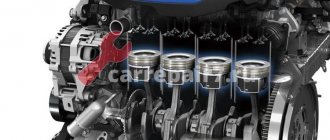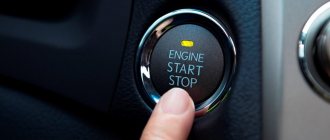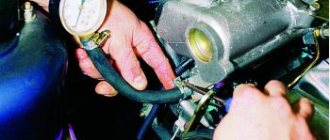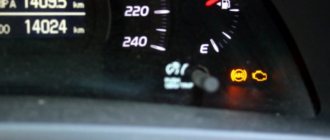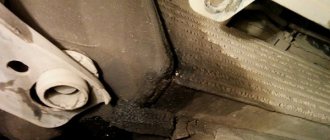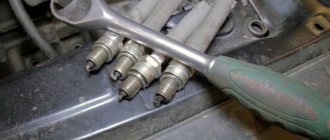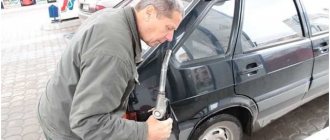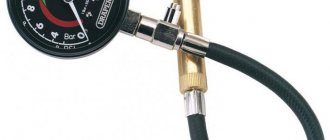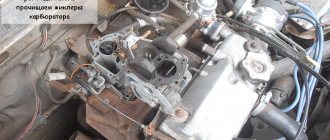Any misfortune or problem can happen to a car. Sometimes you puncture a tire and get into an accident, and sometimes everything is much simpler: a diesel engine misfires when cold. That is, you started the diesel engine, and its cylinders are clearly not working stably.
The problem usually gradually disappears as the engine warms up. But it disappears temporarily, so it definitely needs to be addressed. It is worth noting that diesel engines stall when cold no less often than gasoline engines. There are simply fewer diesel passenger cars than vehicles with gasoline internal combustion engines, which is why we encounter this problem much less frequently.
Causes of diesel engine tripping
Not every motorist can understand why the diesel engine is running cold, looking at the bluish or white smoke coming from the chimney. We will please you with the fact that there are not so many reasons for tripling:
- Loss of compression. When the engine is running, the piston rings must slide tightly along the cylinders, creating mechanical friction and, as a result, wear of parts. As a result, the clearances of valves and cylinder rings increase. The tightness of the entire system decreases and during the next engine stroke, the required pressure is not achieved in the cylinder to ignite the fuel.
- Problems with the fuel system. If the tightness of the fuel system is broken, when air enters it, a reliable cold start becomes a problem.
- Problems with glow plugs. Glow plugs in a diesel engine heat the combustion chamber for trouble-free cold starts. Heating of the combustion chamber is due to the design of the engine itself, as well as the characteristics of diesel fuel.
- Cold injector jams. Fuel is injected into the engine through the injectors at the required intensity to atomize it as best as possible. If the injectors are clogged or faulty, this may cause the engine to misfire and stall both cold and hot.
Diesel shakes and smokes: problems with fuel supply
If there are problems with the fuel supply, then the diesel engine starts to stall for the following reasons:
- the fuel pump does not create optimal pressure in the fuel supply system;
- the injection intensity is disrupted as a result of a malfunction of the diesel injector;
In both cases, fuel atomization deteriorates and the mixture does not burn completely. The fuel injection pump can create normal pressure, but the fuel injectors deliver different amounts of fuel to the cylinders. In such conditions, fuel is distributed unevenly among the cylinders, the engine shakes in different operating modes. If it is completely impossible to pump a portion of diesel fuel through the nozzle, the diesel engine begins to stall. Cleaning, repairing, or replacing injectors must be accompanied by adjustment of the injectors before installation on the engine.
We also recommend reading the article on how to clean and adjust diesel injectors. From this article you will learn about what malfunctions occur during the operation of injectors, as well as methods for diagnosing and eliminating problems.
At the same time, it is necessary to regulate the fuel injection pump. The pump may be worn out and/or incorrectly adjusted, resulting in insufficient pressure to deliver the required amount of diesel fuel through the rebuilt or replaced injectors. The diesel engine may start to run rough, with detonation. Replacing injectors is necessarily accompanied by checking the performance of the fuel injection pump.
If there are problems with both the fuel pump and the injectors, the parts must be adjusted, repaired or replaced immediately. Detonation on a diesel engine will quickly damage the engine.
Loss of diesel engine compression
Loss of compression is the first reason for a diesel engine to stall. At times, a diesel engine stalls when cold, just like a gasoline internal combustion engine, due to loss of compression. Here, as it heats up, the work stabilizes, because the compaction in the cylinders increases according to the law of physics. That is, they expand when heated, and everything returns to normal. This situation occurs if the parts of the CPG or valve mechanism are not worn to a CRITICAL level.
List of reasons why a diesel engine stalls. Let's start fixing it
26.11.2019
| (Votes: 1, Rating: 5) |
Issues discussed in the material:
- How does engine tripping manifest itself?
- Why does the engine stall when cold or hot?
- In what nodes may the cause of engine tripping be hidden?
- How to diagnose and eliminate the cause of engine tripping
An internal combustion engine is a complex mechanism that requires timely maintenance and necessary repair work. Otherwise, it will work with malfunctions and malfunctions. For example, many car owners notice that the internal combustion engine is difficult to start, its power is reduced, the car consumes more fuel, and extraneous sounds, vibration and noise are observed. In this case, you can forget about stable operation of the motor.
Another symptom of the problem is that the engine is shaking. Moreover, this happens on both gasoline and diesel power units. It doesn’t matter what mileage or condition the internal combustion engine is in, this problem can still occur. We'll look further into the article on what to do in such a situation.
Diesel stalls due to a problem with the fuel system
In order for the engine to start working, the fuel must travel from the gas tank to the engine cylinder, passing through the high pressure fuel pump (HPF) and sprayed through the injectors. Each of these stages can create its own problems.
Components of the engine fuel system A common cause of diesel engine throttling is airing of the system; this phenomenon occurs when air gets inside the fuel system. As a result, one of the cylinders does not receive the fuel-air mixture (or receives it with insufficient fuel) and performs its power stroke differently than the others. The reason may be a malfunction of the high pressure fuel pump (HPF), or a leak in the fuel system as a whole.
Why is there not enough fuel in the cylinder?
Other problems with diesel engine stalling are associated with an insufficient level of the fuel mixture entering the engine cylinders. In this case, tripping also appears on a hot engine and is accompanied by abundant white smoke from the exhaust pipe. Its appearance is associated with the ingress of coolant into the combustion chambers.
The causes of tripping with such symptoms may be the following malfunctions:
- failure or clogging of injectors;
- malfunction of the high pressure fuel pump (HPF).
Diesel engine injectors supply fuel to the cylinder in a strictly prescribed dose according to a specific pattern. Clogging of the injectors is possible due to poor quality diesel fuel or untimely replacement of the fine filter. As a result, fuel is supplied unevenly to the engine cylinders and the engine begins to stall.
Also, tripping can be caused by a malfunction of the high pressure fuel pump (HPF). It is this unit that is responsible for supplying uniform doses of fuel at strictly defined moments. Wear of the fuel injection pump leads to insufficient pressure in the fuel system and a decrease in the intensity of fuel injection into the cylinders. The injection pump simply cannot push a sufficient dose of fuel through the injectors. As a result, the engine triples again.
Most often, the plunger pair in the fuel injection pump fails. Over time, its wear leads to the fact that the diesel engine stops starting altogether, since fuel stops flowing into the cylinders. At the same time, sometimes starting the engine from a pusher or hot is possible, but when starting from a standstill, the engine does not respond to turning the key. Also, fuel injection pump problems may be related to the fuel line, then the engine will trip constantly due to fuel leaks.
The third reason for the tripping associated with the fuel injection pump is associated with incorrectly configured fuel injection. On many car models, the fuel injection pump is equipped with a device that allows the engine speed to increase during a cold start, due to which the injection advances - fuel enters the still unheated engine. As the engine warms up, the speed decreases to standard values. Under load, on the contrary, there is a delay in injection for complete combustion of the fuel mixture.
As the injection pump wears out, this operating pattern is disrupted. The fuel injection advance angle no longer corresponds to the crankshaft speed. As a result, fuel stops getting into the cylinders in a timely manner and the diesel engine begins to stall. In this case, the effect can occur as the engine speed increases and the engine heats up, that is, when “cold” the engine works properly, but “when hot” it starts to malfunction.
Glow plug malfunction
Glow plugs, at least indirectly, take part in the atomization of fuel. When injection occurs, diesel fuel, flowing in a high-pressure jet from the nozzle, inevitably hits the hot plug. This makes the fuel in the cylinder atomized even more efficiently. Contact with the spark plug ensures that the diesel fuel scatters into small particles, the fuel partially evaporates and is guaranteed to mix better with the air.
All this ensures the most efficient combustion of the fuel-air mixture in the cylinder. If the condition of the spark plug is not working, then you will definitely not be able to successfully start a cold diesel engine. The temperature in the cylinder will drop, which is why the fuel is no longer capable of self-ignition. Fuel will continue to flow into the cylinder, but it will be virtually inactive. The fuel then enters the exhaust system, causing the engine to start smoking black or dark gray exhaust.
When the temperature in the internal combustion engine rises, the diesel fuel will still light up, but only if everything is in order with compression. However, even in this case the unit will work with obvious interruptions and delays. When the diesel engine warms up well, the problem will disappear, but then it will happen again.
Why doesn't fuel ignite?
Incomplete ignition of the mixture in the cylinders can be due to two reasons:
- insufficient compression in one or more engine cylinders;
- problems with glow plugs.
Ignition in a diesel engine cylinder is ensured by dynamic air compression. In order for the fuel mixture to ignite, it is necessary to achieve a certain level of pressure, which increases the temperature of the air in the combustion chamber.
Reduced compression means that the cylinder does not reach the temperature required for ignition. The reason for insufficient compression is an increase in the gaps between the elements of the cylinder-piston group, as well as between the valves of the gas distribution mechanism. As a result, after fuel is injected into a cylinder with insufficient compression, it does not burn completely or does not ignite at all.
If the gaps between the elements of the cylinder-piston group are small, then after the engine warms up they decrease, the compression level is restored, and the fuel begins to burn smoothly. As a result, tripling stops. Therefore, with insufficient compression, tripping is typical precisely on an unheated engine at idle speed. If the wear of the elements of the cylinder-piston group is sufficiently large, then the tripping does not stop even when the engine is warm.
Another cause of poor fuel ignition is problems with glow plugs. At the same time, the symptoms of the problems are similar: there is also a tripping at idle after starting, which disappears as the engine warms up. A failed glow plug does not maintain the temperature in the cylinder necessary to ignite the fuel. After warming up, the air temperature in the cylinder rises to the level necessary for combustion due to the influence of neighboring cylinders, and the engine ceases to be stored.
Another problem is related to the additional function of the glow plug. Fuel entering the cylinder hits the spark plug and is better atomized in the cylinder. Thanks to this, complete mixing of fuel with air is achieved, which contributes to better combustion of the fuel-air mixture. When the heated glow plug rod fails, the fuel stops mixing effectively with air, and the engine begins to stall.
The engine runs rough both on gas and at idle speeds
Interruptions in engine operation in all modes indicate either problems in the power system or irregular valve timing. But, however, there may be more serious problems - such as burnout of the piston crown or breakdown of timing parts (for example, breakage of valve springs or burnout of a valve).
Interruptions in engine operation in all modes indicate either problems in the power system or irregular valve timing. Typical malfunctions of the power system include clogging of injectors, fuel filters, air leaks and are determined during complex diagnostics https://diesel-remont78.ru.
Even cleaning the injectors of a modern diesel engine requires quite expensive equipment, let alone repairing the injection pump... Therefore, if the diesel engine is running “hot” at idle, it is best to contact a qualified specialist. Self-repair can lead to unjustified expenses - if you randomly replace parts, then diagnostics and repairs will cost a pretty penny. Sometimes, even for a specialist, it’s a mystery “why does a diesel engine stall?” becomes a tough nut to crack - modern fuel equipment cannot be diagnosed by eye, and the abundance of electronics does not make the task easier. If old diesel engines could operate practically under water (provided that it did not enter the intake tract), then a modern engine can simply stall in wet weather.
How dangerous is the situation when the engine starts to stall?
If the engine in your car starts to misfire, you may experience a lot of unpleasant moments in the car’s behavior. In particular, the activity of the power unit decreases, its power decreases, and fuel consumption increases. In some situations, when the power unit is tripled, the consumption is multiplied several times. Each engine has its own design features that determine the behavior of the unit in case of certain problems. When the engine misfires, there is a danger of getting the following troubles:
- a sharp change in compression in one of the cylinders, which causes uneven engine wear;
- in some units this situation may be reflected by serious damage inside the unit;
- loss of power shifts the entire potential load onto the remaining working cylinders;
- the car consumes an incredibly large amount of fuel for it, spoils the oil in the crankcase;
- When the cylinder is not working, the supplied fuel is drained into the crankcase, where it dilutes the oil and deprives it of viscosity;
- the power unit vibrates significantly, which can cause certain damage under the hood.
It all depends, of course, on the type and design of your car. It can be argued that a triple power unit cannot do anything bad; you can safely operate it until you have money for repairs. In fact, it is better to take advantage of the service station’s offer immediately after you feel a change in the operation of the unit. Smooth or sudden changes in the engine's mood should alert the driver and force him to pay attention to the car.
Dear friends, we urge you to start the unit once again when the engine is tripping and not to unnecessarily force the car to work for tens of minutes with a problem, like the hero of the following video:
Source
Trouble-shooting
To resolve a problem, you must first diagnose it. To do this, you need to determine exactly which cylinder the problem lies in. This can be done using diagnostics at a service center, but there is also an old proven method - one by one removing the high-voltage wires from the glow plugs.
The car needs to be started and kept at 1500 RPM. Then you need to remove the wires from the spark plugs one by one. If after removal the sound of the engine changes, the cylinder is OK; if the sound does not change, then it does not work. Removing and putting on high-voltage wires should be done with care, using gloves and a wooden or rubber footrest for grounding.
Lack of compression is detected using a pressure gauge. To solve the problem, you will have to repair the engine, including possibly boring the cylinder block.
You can determine the failure of a glow plug visually by the presence of carbon deposits or using a tester. If the glow plugs malfunction, they are simply replaced with new ones.
You can determine the failure of a particular injector by simply swapping it with the neighboring one. If after this the neighboring cylinder no longer works, then the injector is to blame. You can solve the problem by trying ultrasonic cleaning or soaking in a solvent. This method does not always help, so it is easier to replace the nozzle with a new one.
If fuel injection timing is to blame for the tripping, then you can try to adjust the injection pump so that the ignition timing changes. It is possible to achieve that tripping will occur only on a cold engine, and as it warms up it will disappear.
The hardest thing for a car owner will be if the tripping is associated with wear of the fuel injection pump. In this case, most likely, you will have to change the plunger pair, or even the assembly itself. Repairing fuel injection pumps on your own is quite problematic.
Engine tripping is a common problem with diesel engines. In this case, it is necessary to find out the cause of the problem as quickly as possible and begin to solve it. When tripling, one of the cylinders does not work correctly or does not function at all, which leads to increased load on the remaining cylinders and rapid wear of the cylinder-piston group.
Source
Reasons why a gasoline engine stalls when cold
To independently determine the cause of unstable engine operation, you need to check the spark plugs. In order to unscrew them, you will need a special spark plug wrench.
Based on the state of carbon deposits on them, the search for the problem can be localized. To avoid erroneous conclusions, the check should be carried out after a long trip. In parallel with this procedure, it is necessary to check the condition of the insulating layer of high-voltage wires.
If it shows signs of damage, replacement is necessary. In most cases this will be sufficient. If there are no signs of damage, you need to check the resistance with a multimeter. The indicators must correspond to the characteristics of the wires.
How to determine if the engine is stalling?
In order to determine why a diesel engine stalls during operation, you need to start from something. It is necessary to compare the sound of the engine at the moment and before. It is also worth paying attention to the speed stability - is there a loss in power during acceleration. For experienced car owners, these procedures should not present any difficulties.
Engine tripping can be determined when it reaches operating temperature, i.e. on a warm engine. To do this, you need to go to the exhaust pipe and evaluate the sound of the exhaust. If it contains clearly distinguishable muttering sounds, then this indicates the urgency of the problem. Moreover, this check must be performed on a warm engine, since when it is cold, the described sound can be produced by working mechanisms.
With the engine running, you need to listen to how the unit operates in idle mode. If the engine twitches or its operation is unstable, this may indicate problems with one of the cylinders. If there is not enough experience to determine the problem in question or there are doubts, then you should contact a service station. In any case, when the engine fails, this is a breakdown that cannot be delayed.
